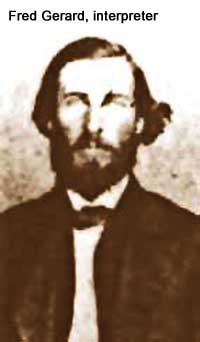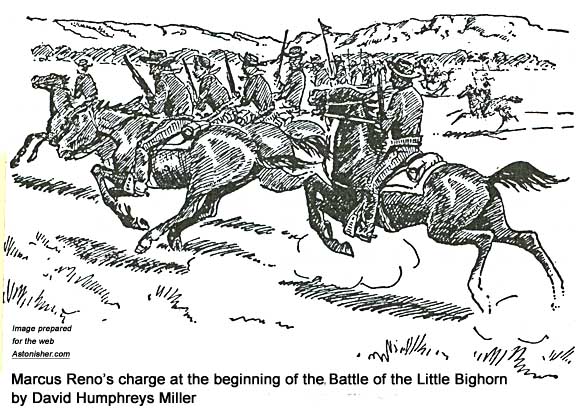|
||||||||||||
Bruce Brown's 100 Voices... Fred Gerard's Story of the Battle
ON JUNE 22d, Custer's command left the mouth of the Rosebud looking for Indians. On June 24th, we broke camp and marched all day and in evening went into camp. The men had supper and grazed their horses and then marched all night till 4 A.M., when a halt was called. The horses remained saddled but the soldiers slept on the ground as best they could. Two Arikara scouts arrived from Lieutenant Varnum, who had been sent out to reconnoitre and locate Indian camps. They brought word of a very large camp down in Little Big Horn Valley, but the Indians had discovered us and were on the run. Custer ordered me to go with him and the two Arikara scouts who had come in from Varnum and two of our scouts, to where Lieutenant Varnum was. About daybreak we reached Varnum and could see the large black mass moving in front and down the Little Big Horn and a dense cloud of dust over all and behind. The camp we had found was the smaller camp (the larger camp was downstream farther), and was on the way to the larger camp and this led us all to believe that the Indians were stampeded. Custer and his party with Varnum and his scouts started back to rejoin the command at a sharp gait. Before reaching his troops, about half way back, Tom Custer met us at the head of the troops and Custer addressed him saying: "Tom, who in the devil moved these troops forward? My orders and intentions were to remain in camp all day and make a night attack on the Indians but they have discovered us and are on the run." After joining the troops, Custer with his officers held a consultation and decided it would be better to follow the Indians so he divided his command into three battalions, one under his own command, Benteen in command of the second, and Reno of the third. Benteen he sent to the left of the command to overlook the ridges as we marched down the valley. He then ordered Reno to take his command and try to overtake the Indians and bring them to battle while he himself would support him. Custer said: "Take the scouts with you." Reno started on the double quick down the valley until he came to the Little Big Horn. Up to that time we were all still under the impression that the Indians were running away. Upon reaching the ford of the Little Big Horn, I discovered that the Indians were coming back to give us battle and called Reno's attention to this change in their movements. Reno halted for a few seconds and ordered the men forward. Thinking that Custer should know of this change of front on the part of the Indians, I rode back at once to tell Custer the news. At an abrupt turn I met Cook, [Lt. W.W. Cooke] Custer's adjutant, ahead of his command, who said: "Girard, what's up?" On hearing the news he ordered me back to Reno's command and rode to inform Custer of the change in the front on the part of the Indians. I rejoined Reno's command just as he was drawing up his men on the skirmish line. The men were almost six feet apart along the brow of a hill below which was a belt of timber. As the Indians came charging back the men used the timber for cover and the Indians rode by on the left and around to the higher ground at the rear and left. Not more than four rounds had been fired before they saw Custer's command dashing along the hills one mile to their rear. Reno then gave the order: "The Indians are taking us in the rear, mount and charge." This was then about 1:30 P.M. I was surprised at this change of position as we had excellent cover and could hold off the Indians indefinitely, but the orders were to mount and charge. Charley Reynolds was killed as he rode up the slope at the left and Isaiah [Isaiah Dorman] a little farther out. Reno led his men in Indian file back to the ford above which he had seen Custer's command pass. The Indians picked off the troops at will; it was a rout, not a charge. All the men were shot in the back, some men fell before high ground was reached. As soon as the hill was gained, Benteen and his command came up and the demoralization of Reno's men affected his own men and no attempt was made to go to Custer's aid. They remained where they were though it was about 2 P.M. and no Indians attacked them for more than an hour. After Reno's command left, I found in the timber Lieutenant de Rudio, Sergeant O'Neill and Wm. Jackson, the half-breed Blackfoot scout, who were also cut off from the command. All the afternoon we could hear the troop volleys, but the scattering fire of the Indians gradually predominated till we were sure that the Indians had won. The fight where Reno's men were began shortly after 4 and kept up till dark. We remained where we were till dark and then struck out west thinking Reno's command had returned. We missed the morning ford and tried the ford Reno used to retreat by but the dead bodies made the horses snort and the water looked too deep so we returned and found a new ford. As we mounted the bank we saw a match lit and called out: "There are the troops, Hello!" and then the match was put out. As we neared the old crossing we saw the Indian lances against the sky and the Indians hearing us turn off suddenly, called out, "Are you afraid, we are not white troops." De Rudio and O'Neill lay down and hid in the brush at this point while Jackson and I rode down and across the stream straight against a cut bank. Both horses threw their riders, our guns were lost, but finally a ford was found and just at dawn we rode out on the prairie. At the left we could hear more Indians coming across the Little Big Horn, coming down to attack Reno. Then we galloped hard to the bunch of willows at the right and reached it before the Indians came out of the water. Here we remained till dark. About 11 A.M. we saw them attack Reno's camp. About one hour before sunset a great talking and confusion arose, the Indians evidently saw Terry coming and began to fall back. Some left for their village to gather their families while others rode away up the Little Big Horn. The retreating warriors passed by hundreds close to where we lay hid in the willows. The Arikara Narrative of Custer's Campaign against the Hostile Dakotas, June 1876, edited by Orin Grant Libby, North Dakota Historical Collections, Volume 6, State Historical Society of North Dakota, Bismark, ND, 1920 p 160 - 170
THIS ACCOUNT of the battle by Gerard is important because it shows that Custer knew the Indians weren't running from Reno, they were coming out "to give us battle," as Gerard put it, intelligence that was corroborated by the separate report by Crow scout Hairy Mocassin, who told Custer that Reno's men were "fighting hard." And since Custer also knew from Reno's Powder River scouting expedition that the Indians outnumbered Reno's troops by at least 10-to-1, he also knew that he absolutely HAD to provide the support he had promised Reno ASAP. This meant Custer had to either directly reinforce Reno or attack somewhere else to keep the much larger Indian force off balance -- otherwise he had sent Reno and his 112 men on a suicide mission. And this in turn underlines the fact that the ONLY plausible explanation for the timid, rudderless behavior of Custer's doomed command after Custer's failed attack at Medicine Tail Coulee is that Custer was shot trying to cross the river -- as White Cow Bull described, and Pretty Shield confirmed -- and was no longer commanding his men. See Who Killed Custer - The Eye-witness Answer for more info... For more information on Custer's scouts, please see The Twisted Saga of the Unsung Seventh Cavalry Scouts. Fred Gerard was also known as Frank Gerard, F.F. Gerard, F.F. Girard, Fred Girard, Frank Girard, Frank Gerard and other variants, but should not be confused with Frank Gruard, who was a scout for General Gibbon-- Bruce Brown
|
||||||||||||




 F. F. GIRARD'S STORY OF THE CUSTER FIGHT
F. F. GIRARD'S STORY OF THE CUSTER FIGHT








